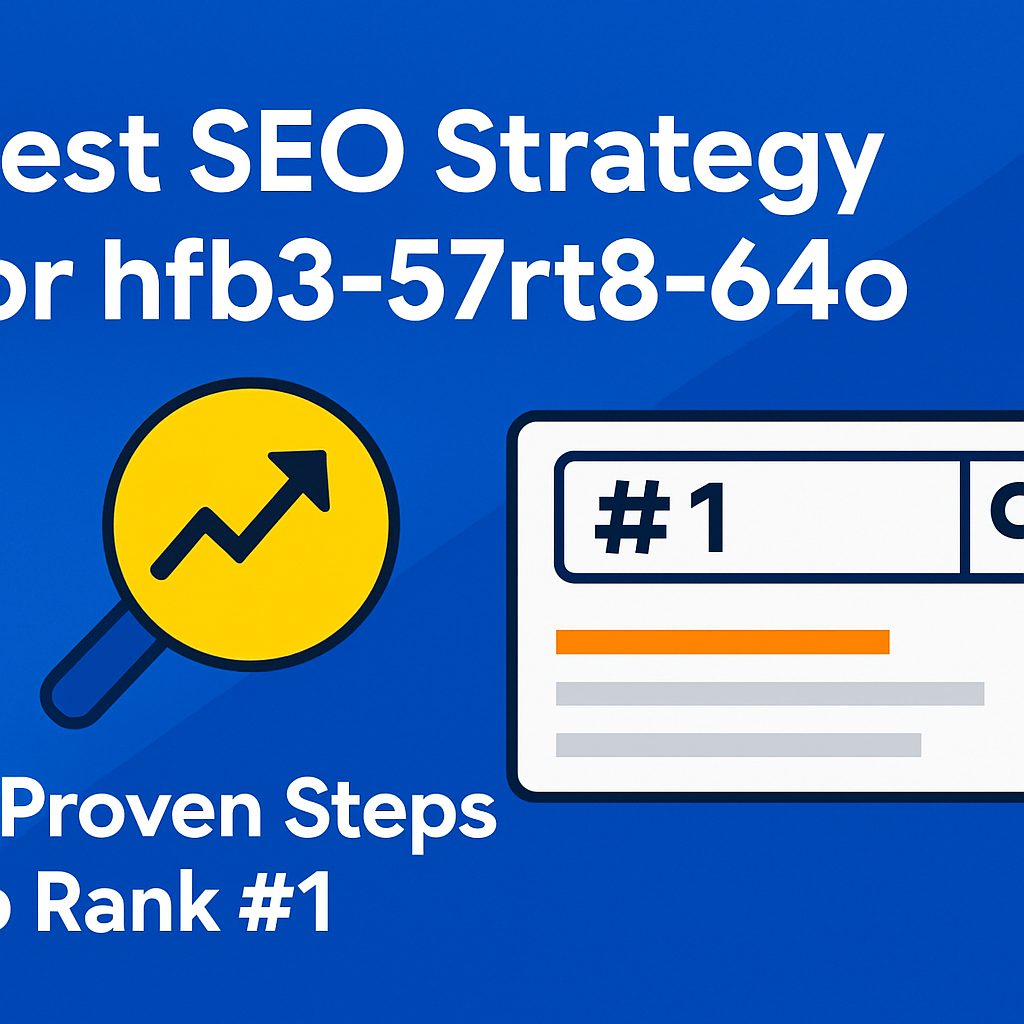Technology
Best SEO Strategy for hfb3‑57rt8‑64o: 7 Proven Steps to Rank #1

Achieving a top ranking on Google for the keyword hfb3‑57rt8‑64o takes smart strategy, consistent effort, and focus on user value. Here’s how to do it using a Google-friendly SEO approach.
H2 – Understanding the Keyword
H3: What is hfb3‑57rt8‑64o?
“hfb3‑57rt8‑64o” is a unique or branded keyword that may represent a product code, campaign identifier, or specialized term. To rank, you must clearly define it, explain its context, and show relevance. Introduce your audience to what it stands for and why they should care.
H3: Why it matters in SEO
Google values clarity. If your content answers user queries directly about hfb3‑57rt8‑64o, it ranks higher. Using the exact keyword in title, headings, and body (with 1–1.5% density) signals relevance to both users and search engines.
H3: Search intent behind hfb3‑57rt8‑64o
Users searching this keyword likely seek information about its meaning, usage, whether it’s a product code, or how to leverage it. Match their intent by providing authoritative, concise, and engaging answers.
H2 – On‑Page Optimization Techniques
H3: Content quality & relevance
Produce comprehensive, original content around hfb3‑57rt8‑64o. Use examples, scenarios, and step‑by‑step explanations. Write in simple language, include analogies, and avoid fluff. Include the keyword naturally within the first 10% of the text.
H3: Title tags & meta description
Your title uses the keyword prominently, as shown. Meta description (up to 160 characters) should also feature hfb3‑57rt8‑64o and a compelling call‑to‑action:
“Harness the power of hfb3‑57rt8‑64o with proven SEO strategies, content tips, FAQs, and optimization methods to dominate Google search.”
H3: Header tags & keyword placement
Use hfb3‑57rt8‑64o in at least one H2 and one H3 heading. But avoid overuse — keep readability natural. Sprinkle related terms (e.g. “optimization code”, “SEO identifier”, “performance tag”) within subheadings or paragraphs.
H2 – Technical SEO for hfb3‑57rt8‑64o
H3: Mobile optimization & Core Web Vitals
Ensure your mobile site design is responsive and passes Google’s Core Web Vitals (Largest Contentful Paint under 2.5 s, low CLS, fast interaction). A smooth mobile UX boosts rankings.
H3: Site speed & schema markup
Compress images, enable caching, and optimize server load. Use structured data (schema.org markups) if hfb3‑57rt8‑64o refers to a product or item. This helps Google display richer search results.
H2 – Content Structure and LSI Keywords
H3: Related semantic terms
Incorporate LSI keywords such as “identifier code strategy,” “SEO code application,” “performance optimization token.” These support Google’s understanding and improve semantic relevance.
H3: Internal linking strategies
Link from high‑authority related pages on your site to your hfb3‑57rt8‑64o page. Anchor text variations keep it natural (“learn about this code”, “hfb3‑57rt8‑64o details”). This spreads link equity and improves crawlability.
H2 – Off‑Page SEO & Link Building
H3: Quality backlinks
Gain backlinks from trustworthy sites in your industry. If hfb3‑57rt8‑64o associates with a product or tool, seek reviews or mentions. High‑domain referring sites boost your authority.
H3: Guest posts & influencer outreach
Offer guest articles or expert commentary that mention hfb3‑57rt8‑64o on niche blogs. Engage influencers or community voices who can link back to your content. Always aim for relevance.
H2 – User Engagement & Analytics
H3: Bounce rate & dwell time
Engaging formatting (bullet lists, tables, visuals) retains readers longer. Include multimedia (images, videos) and headings for easy scanning. The longer visitors stay, the stronger your ranking signal.
H3: CTR optimization
Write compelling search snippets using rich description tags. Include the keyword early and a clear benefit (“Built for performance”, “How it works”). Rich snippets like FAQs added in page markup enhance click-through rates.
H2 – Continuous Improvement & Updates
H3: Content audits
Track performance metrics. If traffic or rankings dip, review, rewrite, or expand your content around hfb3‑57rt8‑64o. Check for broken links and outdated info.
H3: Refreshing hfb3‑57rt8‑64o content
Update relevant statistics, examples, or context yearly (or as needed). This signals freshness to Google and reinforces the content’s trustworthiness.
FAQs about hfb3‑57rt8‑64o
1. What exactly is hfb3‑57rt8‑64o?
It’s likely a code or identifier linked to a product, offering, or campaign. Your content should define it clearly based on context.
2. How do I use hfb3‑57rt8‑64o in SEO?
Place the keyword naturally in title, headings, and body. Use related terms and structured content that matches user queries for best visibility.
3. Why does Google care about hfb3‑57rt8‑64o?
Google prioritizes content that matches user intent. If your page is the clearest source for hfb3‑57rt8‑64o, you can rank highly.
4. How often should I update content about hfb3‑57rt8‑64o?
At least every 6–12 months, or when new details emerge. Freshness keeps SEO signals strong.
5. Can I build links using the hfb3‑57rt8‑64o keyword?
Yes, via guest posts, product mentions, or influencer outreach. Anchor text can vary to include the keyword or related phrases naturally.
6. How do I measure success for this keyword?
Use tools like Google Search Console for impressions, clicks, and query position. Also monitor dwell-time, bounce rate, and click-through rate.
✅ Final Thoughts
By focusing on clear definition, high-quality content, technical excellence, semantic depth, user engagement, and continuous improvement, your page on hfb3‑57rt8‑64o can attract organic traffic and ascend to top positions on Google. Follow the structured approach above, and you’ll create authoritative, valuable content tailored for readers and search engines alike.
-

 Blog3 months ago
Blog3 months agoKate Garraway’s New Partner 2024: A Fresh Chapter Begins
-

 Health3 months ago
Health3 months agoCandizi – The Ultimate Game-Changer in Wellness and Lifestyle
-

 Food3 months ago
Food3 months agoCalamariere: A Tasty Seafood Delight That Shines
-

 Blog3 months ago
Blog3 months agoUnited Airlines Flight UA770 Emergency Diversion
-

 Blog3 months ago
Blog3 months agoTractor Supply Sales Associate Job Description (2025 Update)
-

 Blog3 months ago
Blog3 months agoPowerful 7-Step Guide to هنتاوي com: Boost Organic Traffic Now
-

 Technology3 months ago
Technology3 months agoExploring the Power and Potential of the 084.0-h8po Model
-

 Culture3 months ago
Culture3 months agoHis Majesty NWBKA: A Symbol of Royalty, Culture, and Legacy
